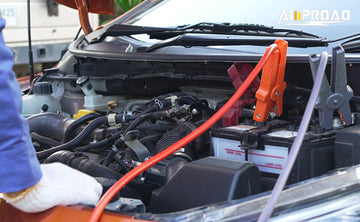
In times of car trouble, jump starters prove to be invaluable, providing a quick fix for dead batteries. But what powers these handy devices? Let’s explore how they function, their essential role in bringing vehicles back to life, and how they keep your travels hassle-free.
What is a Jump Starter?
A jump starter is a portable device designed to jump-start a vehicle with a dead battery. Essentially, it acts as an external power source that provides the necessary boost to kick-start the engine when the vehicle's battery is unable to do so on its own. Jump starters typically consist of a compact battery pack housed in a durable casing, along with cables equipped with clamps that connect the jump starter to the vehicle's battery terminals. They come in various sizes and power capacities, catering to different types of vehicles and their specific battery requirements.
The primary function of a jumper starter is to revive a vehicle with a depleted or discharged battery. When a vehicle's battery loses its charge due to factors like prolonged non-use, extreme weather conditions, or electrical issues, the engine may fail to start. This is where a jump starter comes in handy. By connecting the jump starter's cables to the corresponding terminals on the vehicle's battery, the stored power within the car jump starter is transferred to the battery, providing the necessary energy to start the engine. This process bypasses the need for another vehicle to jump-start the dead battery, making jump starters a convenient and practical solution for roadside emergencies.
In essence, jump starters serve as a reliable backup plan for motorists facing unexpected battery failures. Whether stranded in a remote location or caught off guard by a dead battery in the driveway, having a jump starter on hand can provide peace of mind and ensure a swift resolution to the problem. With their compact size and user-friendly operation, jump starters are an indispensable tool for vehicle maintenance and roadside assistance, offering a quick and efficient solution to common battery-related issues.
How Does a Jump Starter Safeguard Vehicles?
Traditional jump-start methods, such as using jumper cables connected to another vehicle's battery, can pose risks to both vehicles involved. One common concern is the potential for electrical damage or short circuits due to incorrect connection of the jumper cables, which can result in costly repairs. Additionally, the process of jump-starting a vehicle with cables requires another vehicle to be present, which may not always be feasible in remote locations or during emergencies. These challenges highlight the need for a safer and more reliable alternative, such as jump starters.
Jump starters offer a safer and more controlled method of jump-starting vehicles, reducing the risk of electrical damage or mishaps. Unlike traditional jump-start methods that rely on another vehicle's battery, jump starters deliver controlled power directly to the vehicle's battery, ensuring a stable and consistent power supply. This helps prevent voltage spikes or surges that could potentially damage the vehicle's electrical system, including sensitive electronics and components. By providing a controlled power delivery, jump starters minimize the risk of vehicle damage and offer a safer alternative to traditional jump-start methods.
Furthermore, modern jump starters are equipped with built-in safety features to further safeguard vehicles and users during the jump-starting process. These safety features may include reverse polarity protection, which prevents damage caused by incorrect cable connection, and spark-proof technology, which eliminates the risk of sparks or electrical arcs during the connection process. Additionally, some jump starters may feature overload protection to prevent excessive current flow and overheating, further enhancing safety for both vehicles and users. With these built-in safety features, jump starters provide peace of mind and confidence, ensuring a smooth and hassle-free jump-starting experience for motorists facing dead battery emergencies.

What Components Make Up a Jump Starter?
A jump starter typically consists of several key components that work together to provide a reliable and effective solution for jump-starting vehicles. At the heart of a jump starter is its battery, which stores the necessary electrical energy to deliver a power boost to the vehicle's battery. The battery is usually a high-capacity lithium-ion or lead-acid battery, chosen for its ability to store and deliver power efficiently. Connected to the battery are heavy-duty cables equipped with clamps that attach to the terminals of the vehicle's battery. These cables serve as the conduit through which power is transferred from the jump starter to the vehicle's battery, jump-starting the engine.
In addition to the battery and cables, jump starters may also feature various safety features designed to protect both vehicles and users during the jump-starting process. These safety features often include reverse polarity protection, which prevents damage caused by incorrect cable connection by automatically detecting and correcting polarity errors. Another common safety feature is spark-proof technology, which eliminates the risk of sparks or electrical arcs during the connection process, reducing the likelihood of accidents or damage. Additionally, some jump starters may include overload protection to prevent excessive current flow and overheating, further enhancing safety and reliability.
Quality construction and materials are essential considerations in vehicle battery booster design to ensure durability, reliability, and safety. High-quality components, such as robust casing materials and corrosion-resistant clamps, help withstand the rigors of frequent use and adverse conditions, such as extreme temperatures or humidity. Additionally, rigorous testing and certification processes ensure that jump starters meet industry standards for performance and safety. By investing in a well-designed and quality-built jump starter, motorists can have confidence in their ability to jump-start vehicles safely and effectively whenever the need arises.
How Do You Properly Use a Jump Starter?
Properly using a jump starter is crucial for safely and effectively jump-starting a vehicle with a dead battery. Here's a step-by-step guide on how to boost a car using a jump starter. Firstly, ensure that both the jump starter and the vehicle are turned off before connecting any cables. Next, locate the battery terminals in the vehicle, typically found under the hood. Identify the positive and negative terminals, usually marked with a plus (+) and minus (-) sign respectively. Then, connect the red clamp from the jump starter to the positive terminal of the vehicle's battery, followed by connecting the black clamp to the negative terminal. Ensure a secure connection, making sure the clamps do not touch each other or any other metal parts.
Once the connections are secure, power on the jump starter, or portable battery booster, and wait a few moments to allow the battery to charge. After a brief period, attempt to start the vehicle. If the engine does not start on the first attempt, wait a few minutes before trying again to avoid overheating the jump starter. Once the vehicle starts, carefully disconnect the clamps in the reverse order they were connected, starting with the black clamp and then the red clamp. Store the car jump box in a cool, dry place, away from direct sunlight and extreme temperatures, to ensure its longevity and optimal performance. Regular maintenance and proper storage are essential for maximizing the lifespan of a jump starter. Periodically check the jump starter's battery level and recharge it as needed to ensure it's ready for use in emergencies. Additionally, inspect the cables and clamps for any signs of wear or damage, replacing them if necessary. Storing the jump starter in its designated case or pouch can help protect it from dust, moisture, and other environmental factors, preserving its functionality and reliability for years to come.

Can You Use a Jump Starter on Different Types of Vehicles?
Jump starters offer remarkable versatility, making them compatible with various vehicle types, ranging from cars and trucks to motorcycles and boats. Their ability to jump-start different types of vehicles stems from their design and power capacity. Whether you're dealing with a compact sedan or a heavy-duty truck, a jump starter can come to the rescue, provided it's appropriately sized for the vehicle in question.
The compatibility of jump starters across different vehicle types is attributed to their varied power ratings and capabilities. Jump starters are available in a range of power outputs, from compact models suitable for small cars to high-capacity units capable of jump-starting larger vehicles like trucks and boats. Additionally, some jump starters are specifically designed for motorcycles and feature compact sizes and lightweight designs for easy portability.
When selecting a jump starter, it's crucial to consider the specific power requirements of your vehicle. Larger vehicles with higher-displacement engines may require a more powerful jump starter to deliver the necessary surge of energy to start the engine. Conversely, smaller vehicles may only require a lower-capacity jump starter. By matching the power rating and capabilities of the jump starter to the vehicle's size and engine type, you can ensure reliable and effective jump-starting performance whenever needed. With their versatility and adaptability, jump starters offer a convenient and dependable solution for addressing dead battery emergencies across a wide range of vehicle types, providing motorists with peace of mind and confidence on the road.
Amproad offers a versatile portable jump starter designed to provide reliable performance in various vehicle jump-starting scenarios. With features like a robust lithium-ion battery and compact, lightweight design, Amproad jump starters are easy to carry and store, making them ideal for emergencies on the road. Equipped with safety features such as reverse polarity protection and spark-proof technology, Amproad jump starters prioritize user safety while delivering the necessary power to jump-start vehicles efficiently. Additionally, Amproad jump starters often come with additional functionalities like built-in LED flashlights and USB charging ports, adding to their versatility and usefulness in emergency situations beyond jump-starting vehicles. Whether you're stranded in a remote location or facing a dead battery in your driveway, an Amproad portable jump starter can be a reliable companion for getting your vehicle back on the road quickly and safely.


